AMD Athlon 64 FX-57: The Fastest Single Core
by Derek Wilson on June 27, 2005 11:47 AM EST- Posted in
- CPUs
Workstation Applications
SPECviewperf 8SPECviewperf is a collection of application traces taken from some of the most popular professional applications, and compiled together in a single set of benchmarks used to estimate performance in the various applications in which the benchmark is used to model. With version 8, SPEC has significantly improved the quality of the benchmark, making it even more of a real world indicator of performance.
We have included SPEC's official description of each one of the 8 tests in the suite.
3dsmax Viewset (3dsmax-03)
"The 3dsmax-03 viewset was created from traces of the graphics workload generated by 3ds max 3.1. To insure a common comparison point, the OpenGL plug-in driver from Discreet was used during tracing.
The models for this viewset came from the SPECapc 3ds max 3.1 benchmark. Each model was measured with two different lighting models to reflect a range of potential 3ds max users. The high-complexity model uses five to seven positional lights as defined by the SPECapc benchmark and reflects how a high-end user would work with 3ds max. The medium-complexity lighting models uses two positional lights, a more common lighting environment.
The viewset is based on a trace of the running application and includes all the state changes found during normal 3ds max operation. Immediate-mode OpenGL calls are used to transfer data to the graphics subsystem."
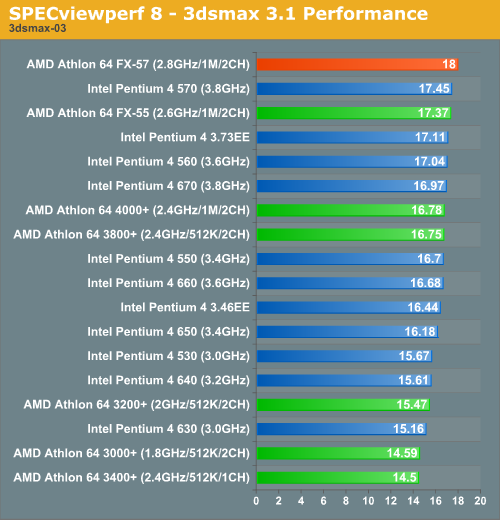
CATIA Viewset (catia-01)
"The catia-01 viewset was created from traces of the graphics workload generated by the CATIATM V5R12 application from Dassault Systems.
Three models are measured using various modes in CATIA. Phil Harris of LionHeart Solutions, developer of CATBench2003, supplied SPEC/GPC with the models used to measure the CATIA application. The models are courtesy of CATBench2003 and CATIA Community.
The car model contains more than two million points. SPECviewperf replicates the geometry represented by the smaller engine block and submarine models to increase complexity and decrease frame rates. After replication, these models contain 1.2 million vertices (engine block) and 1.8 million vertices (submarine).
State changes as made by the application are included throughout the rendering of the model, including matrix, material, light and line-stipple changes. All state changes are derived from a trace of the running application. The state changes put considerably more stress on graphics subsystems than the simple geometry dumps found in older SPECviewperf viewsets.
Mirroring the application, draw arrays are used for some tests and immediate mode used for others."
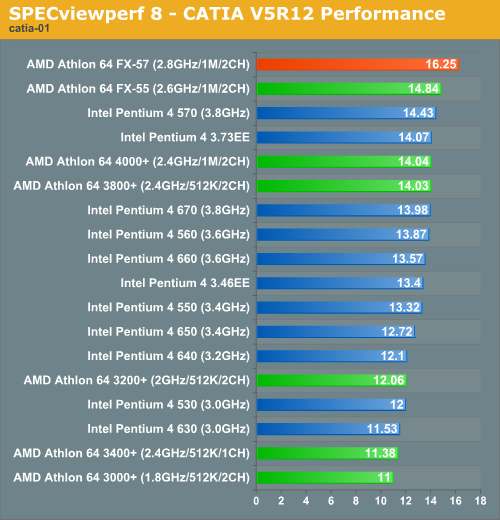
Lightscape Viewset (light-07)
"The light-07 viewset was created from traces of the graphics workload generated by the Lightscape Visualization System from Discreet Logic. Lightscape combines proprietary radiosity algorithms with a physically based lighting interface.
The most significant feature of Lightscape is its ability to accurately simulate global illumination effects by precalculating the diffuse energy distribution in an environment and storing the lighting distribution as part of the 3D model. The resulting lighting "mesh" can then be rapidly displayed."
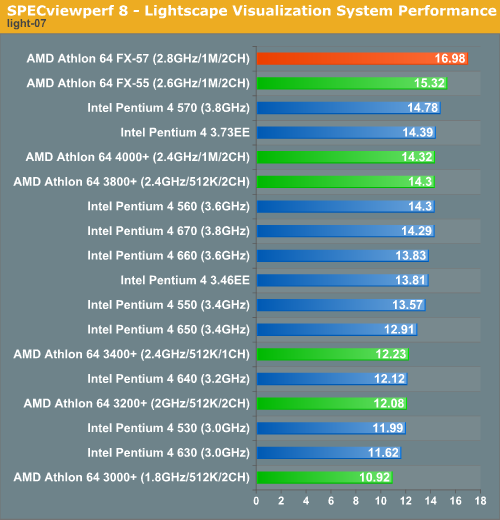
Maya Viewset (maya-01)
"The maya-01 viewset was created from traces of the graphics workload generated by the Maya V5 application from Alias.
The models used in the tests were contributed by artists at NVIDIA. Various modes in the Maya application are measured.
State changes as made by the application are included throughout the rendering of the model, including matrix, material, light and line-stipple changes. All state changes are derived from a trace of the running application. The state changes put considerably more stress on graphics subsystems than the simple geometry dumps found in older viewsets.
As in the Maya V5 application, array element is used to transfer data through the OpenGL API."

Pro/ENGINEER (proe-03)
"The proe-03 viewset was created from traces of the graphics workload generated by the Pro/ENGINEER 2001TM application from PTC.
Two models and three rendering modes are measured during the test. PTC contributed the models to SPEC for use in measurement of the Pro/ENGINEER application. The first of the models, the PTC World Car, represents a large-model workload composed of 3.9 to 5.9 million vertices. This model is measured in shaded, hidden-line removal, and wireframe modes. The wireframe workloads are measured both in normal and antialiased mode. The second model is a copier. It is a medium-sized model made up of 485,000 to 1.6 million vertices. Shaded and hidden-line-removal modes were measured for this model.
This viewset includes state changes as made by the application throughout the rendering of the model, including matrix, material, light and line-stipple changes. The PTC World Car shaded frames include more than 100MB of state and vertex information per frame. All state changes are derived from a trace of the running application. The state changes put considerably more stress on graphics subsystems than the simple geometry dumps found in older viewsets.
Mirroring the application, draw arrays are used for the shaded tests and immediate mode is used for the wireframe. The gradient background used by the Pro/E application is also included to better model the application workload."
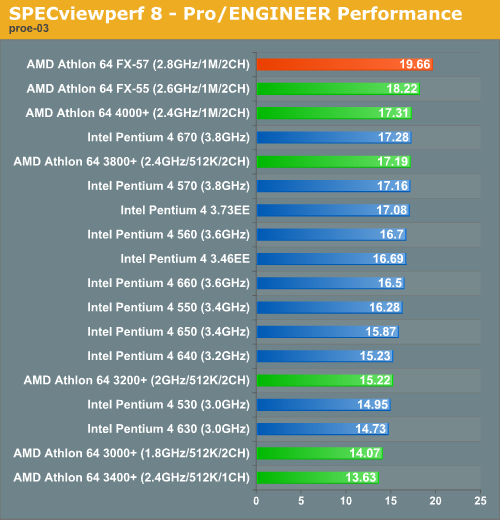
SolidWorks Viewset (sw-01)
"The sw-01 viewset was created from traces of the graphics workload generated by the Solidworks 2004 application from Dassault Systemes.
The model and workloads used were contributed by Solidworks as part of the SPECapc for SolidWorks 2004 benchmark.
State changes as made by the application are included throughout the rendering of the model, including matrix, material, light and line-stipple changes. All state changes are derived from a trace of the running application. The state changes put considerably more stress on graphics subsystems than the simple geometry dumps found in older viewsets.
Mirroring the application, draw arrays are used for some tests and immediate mode used for others."
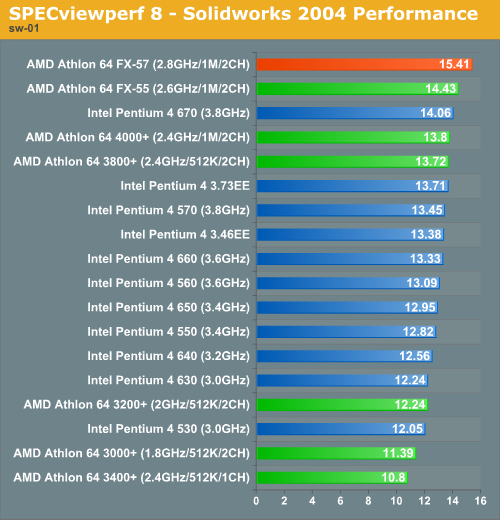
Unigraphics (ugs-04)
"The ugs-04 viewset was created from traces of the graphics workload generated by Unigraphics V17.
The engine model used was taken from the SPECapc for Unigraphics V17 application benchmark. Three rendering modes are measured -- shaded, shaded with transparency, and wireframe. The wireframe workloads are measured both in normal and anti-alised mode. All tests are repeated twice, rotating once in the center of the screen and then moving about the frame to measure clipping performance.
The viewset is based on a trace of the running application and includes all the state changes found during normal Unigraphics operation. As with the application, OpenGL display lists are used to transfer data to the graphics subsystem. Thousands of display lists of varying sizes go into generating each frame of the model.
To increase model size and complexity, SPECviewperf 8.0 replicates the model two times more than the previous ugs-03 test."
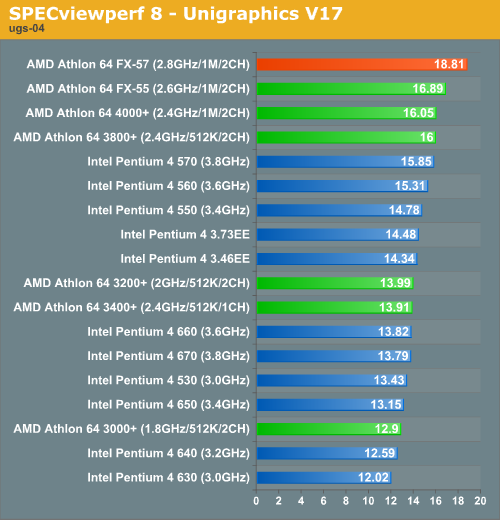










56 Comments
View All Comments
Calin - Tuesday, June 28, 2005 - link
Anyway, what's with the data analysis benchmark? Looks like every Pentium4 beats the hell out of every Athlon64.If this is true, then I feel my suggestions to buy Athlon64 might not always be correct
Calin - Tuesday, June 28, 2005 - link
An processor with 1M level2 cache and dual channel memory controller is a preview of what to expect from a nice cheap 256K cache single channel memory controller? I really really don't think soAtaStrumf - Tuesday, June 28, 2005 - link
This isn't just a speed bump, it's a new revision (SH-E4 I think). Check PCU-Z next time!New Semprons with x86-64 will be even newer revisons - DH-E6 (don't know if that's good or bad yet, but very likely good) so OCing of this new E4 is like the most important thing here because nobody's gonna buy $1000 CPUs, nobody here anyway.
FX-57 is a preview of what to expect of a nice cheap 3300+ Sempron and all you gave it was one line. Try a little harder next time please! If it's true that everybody else is getting 3,0 GHz on air, than that is great news. Just what we have been waiting for!!!
JarredWalton - Tuesday, June 28, 2005 - link
Overclocking is half luck, and there's no telling how the OC benches at other places are really performed. 2.75 GHz "easy" on a Winchester? Fat chance. Maybe with water cooling and the proper motherboard, but even then it's not guaranteed. And don't think the Venice cores are much better - they're really about the same, which means 2.6 to 2.7 GHz air cooled is the typical maximum for a truly stable system.Anyway, if you're into serious cooling and overclocking, the FX-57 might be a bit better than the FX-55. 90nm vs. 130nm I believe, so hopefully it does better. I just can't see dropping $1000 for a single threaded CPU, though. A 4000+ San Diego does almost as well at half the cost, even with overclocking.
composer - Tuesday, June 28, 2005 - link
I don't get it? A AMD64 3200 Winny clocks easy at 2.75 with no problems.Why would someone in the know buy such a proc if they can get the same performance for little money?
Also, why can't they get past 3.0 ghz yet? (air cooling, or do we need to wait for .65 nano?
JustAnAverageGuy - Monday, June 27, 2005 - link
Page 1:"But as we have mentioned time and time again, steadily increasing clock speed over time is a loosing proposition. "
'losing'
Those macro buttons are getting overused. It's the same text in every review, just different charts. :)
Sunbird - Monday, June 27, 2005 - link
The FX-57 is still being called a FX-55 in the Doom3 graphs.Cygni - Monday, June 27, 2005 - link
Oh, in other news, the only thing i felt missing was Dual core results. Could have deffinitly been used.Cygni - Monday, June 27, 2005 - link
Its a speedbump review... i dont think AT, or anybody else, really gives a shit.cryptonomicon - Monday, June 27, 2005 - link
uh, they used the dfi ultra-d to overclock right?else, that is just retarded.